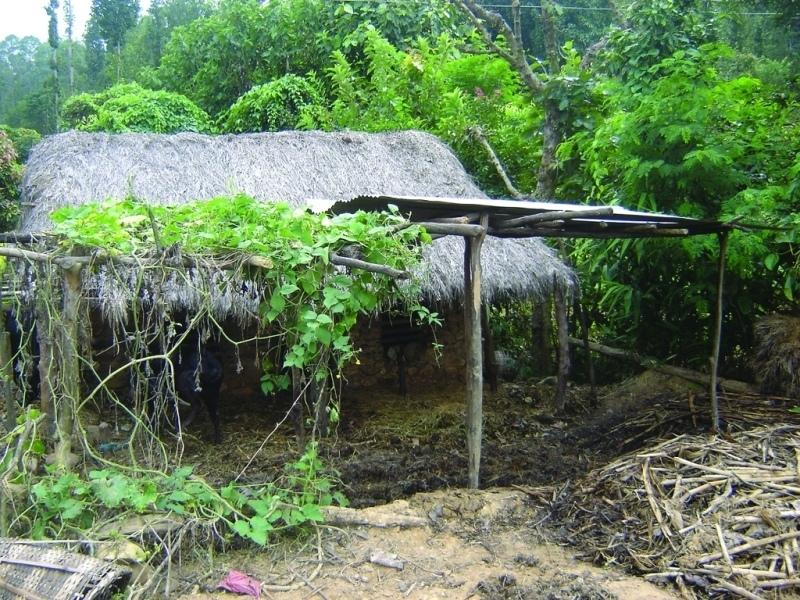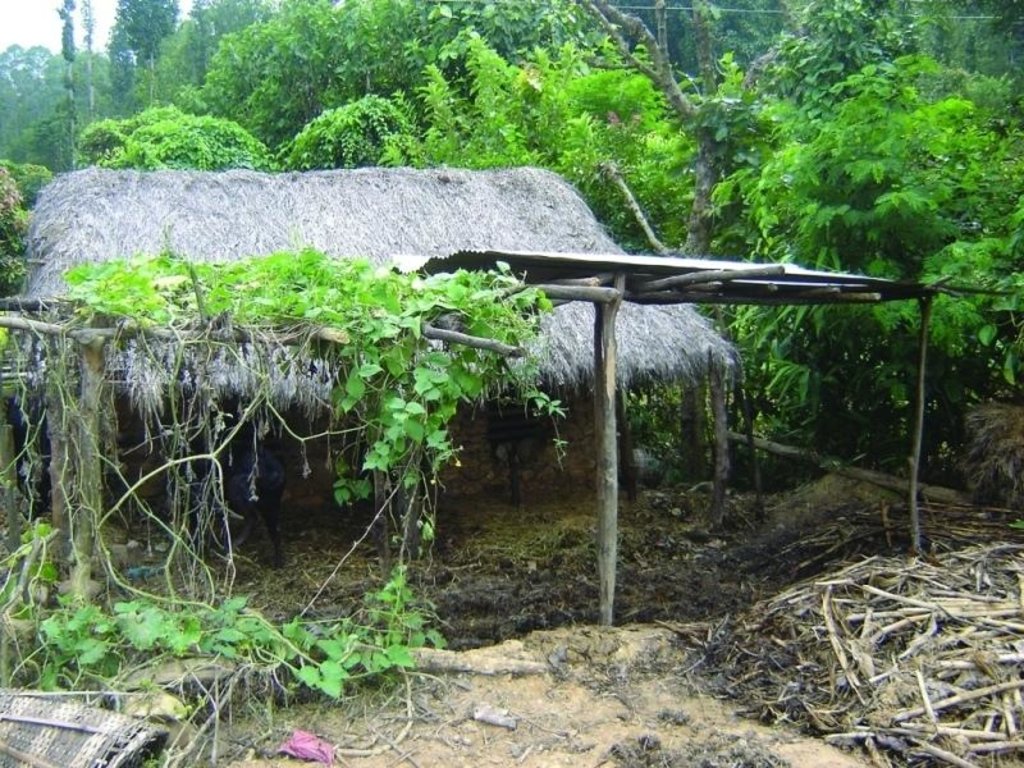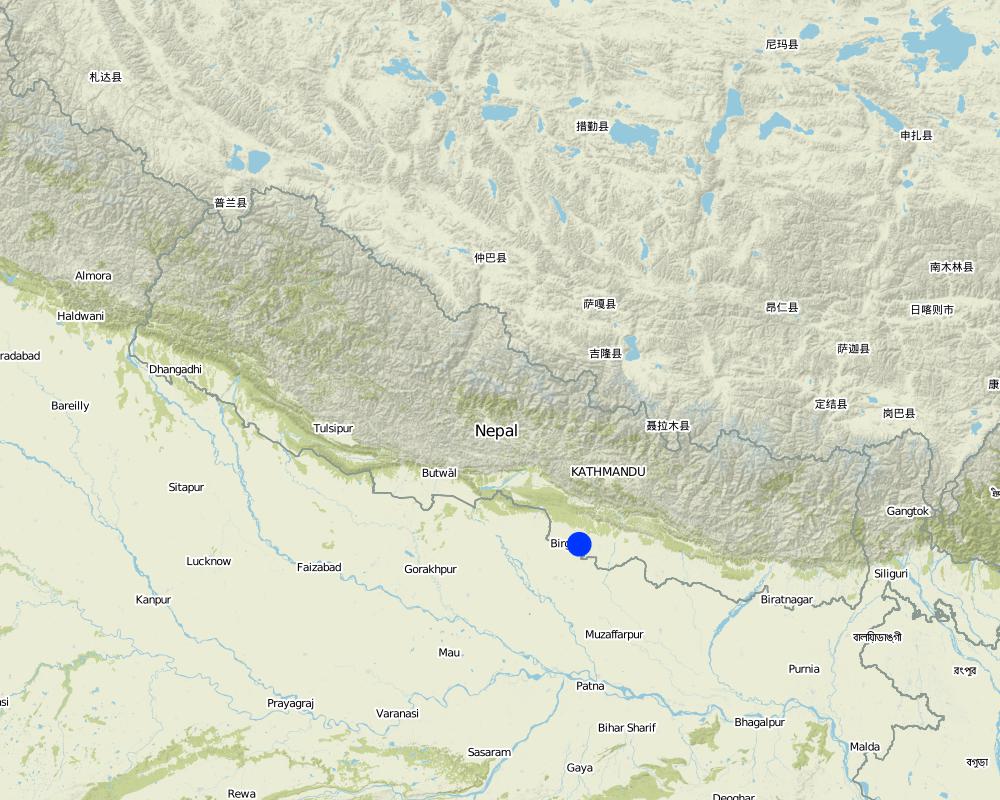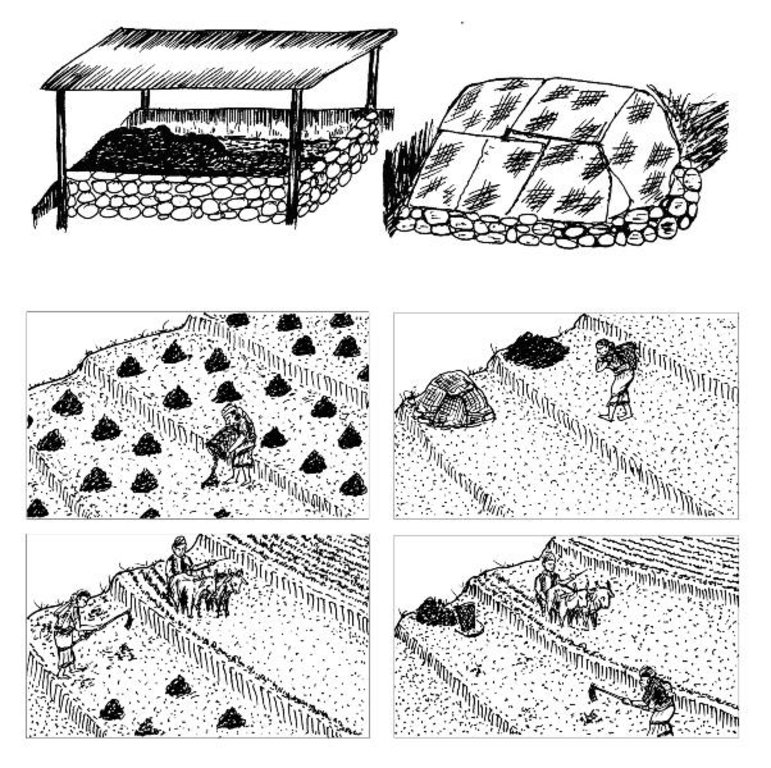Improved farmyard manure through sunlight, rain and runoff protection [ប្រទេសនេប៉ាល់]
- ការបង្កើត៖
- បច្ចុប្បន្នភាព
- អ្នកចងក្រង៖ Richard Allen
- អ្នកកែសម្រួល៖ –
- អ្នកត្រួតពិនិត្យច្រើនទៀត៖ David Streiff, Alexandra Gavilano
Gham, bhalpani ra baleni bata bachai nirman gariyeko ramro gnastar ko gothemal (Nepali)
technologies_1756 - ប្រទេសនេប៉ាល់
ពិនិត្យមើលគ្រប់ផ្នែក
ពង្រីកមើលទាំងអស់ បង្រួមទាំងអស់1. ព័ត៌មានទូទៅ
1.2 ព័ត៌មានលម្អិតពីបុគ្គលសំខាន់ៗ និងស្ថាប័នដែលចូលរួមក្នុងការវាយតម្លៃ និងចងក្រងឯកសារនៃបច្ចេកទេស
អ្នកជំនាញឯកទេស SLM:
Director
Soil Management Directorate, Department of Agriculture
ប្រទេសនេប៉ាល់
អ្នកជំនាញឯកទេស SLM:
Team Leader
Sustainable Soil Management Programme
ប្រទេសនេប៉ាល់
ឈ្មោះគម្រោងដែលបានចងក្រងឯកសារ/ វាយតម្លៃលើបច្ចេកទេស (បើទាក់ទង)
Sustainable Soil Management Programme, Nepal (SSMP)ឈ្មោះអង្គភាពមួយ (ច្រើន) ដែលបានចងក្រងឯកសារ/ វាយតម្លៃបច្ចេកទេស (បើទាក់ទង)
Department of Agriculture, Soil Management Directorate, Hariharbhawan Lalitpur (doasoil) - ប្រទេសនេប៉ាល់ឈ្មោះអង្គភាពមួយ (ច្រើន) ដែលបានចងក្រងឯកសារ/ វាយតម្លៃបច្ចេកទេស (បើទាក់ទង)
HELVETAS (Swiss Intercooperation)1.3 លក្ខខណ្ឌទាក់ទងទៅនឹងការប្រើប្រាស់ទិន្នន័យដែលបានចងក្រងតាមរយៈ វ៉ូខេត
អ្នកចងក្រង និង(បុគ្គលសំខាន់ៗ)យល់ព្រមទទួលយកនូវលក្ខខណ្ឌនានាទាក់ទងទៅនឹងការប្រើប្រាស់ទិន្នន័យដែលបានចងក្រងតាមរយៈវ៉ូខេត:
បាទ/ចា៎
1.5 ការយោងទៅលើកម្រងបញ្ជីសំណួរ (មួយ ឬច្រើន) នៃវិធីសាស្ត្រផ្សព្វផ្សាយ SLM (ដែលបានចងក្រងដោយទស្សនៈពិភពលោកស្តីពីវិធីសាស្ត្រ និងបច្ចេកទេសងអភិរក្ស WOCAT)

Farmer field schools on integrated plant nutrient systems [ប្រទេសនេប៉ាល់]
Participatory and collaborative learning through the farmer field school approach
- អ្នកចងក្រង៖ Richard Allen

Farmer-to-farmer diffusion [ប្រទេសនេប៉ាល់]
Wider diffusion of sustainable soil management technologies through a demand responsive farmer-to-farmer diffusion approach
- អ្នកចងក្រង៖ Richard Allen
2. ការពណ៌នាពីបច្ចេកទេស SLM
2.1 ការពណ៌នាដោយសង្ខេបពីបច្ចេកទេស
និយមន័យបច្ចេកទេស:
Improving farmyard manure by protecting it from direct sunlight, rainfall, and runoff to reduce volatilisation and leaching
2.2 ការពណ៌នាលម្អិតពីបច្ចេកទេស
ការពណ៌នា:
Farmyard manure is the most common form of organic fertiliser applied to crops in the midhills of Nepal. Farmyard manure has a high proportion of organic material which nurtures soil organisms and is essential for maintaining an active soil life. Typically, only about half of the nutrient content of farmyard manure becomes available for crop growth during the first year after it is applied to the soil. The rest of the nutrients are channelled through soil biotic processes and are released in the following years. The high organic matter content and the more active soil life improve or maintain a friable soil structure, increase the cation exchange capacity, the water holding capacity, and the infiltration rate, and reducing the risk of soil pests.
Indigenous methods of preparing and using farmyard manure vary depending on the ecological zone, access to bedding material from crop or forest land and to crop residues and fodder, the availability of labour, and other factors. Traditionally, Nepali farmers take the manure out of their sheds to dry it for 2-3 days and then carry it to the field where it is left in small heaps for a number of days before being spread and incorporated into the soil.
Farmers rate the quality of manure according to which livestock species it comes from. These ratings have been confirmed by nutrient analysis as cattle manure (NPK%: 0.6, 0.13, 0.66) is considered to be better than buffalo manure (0.33, 0.25, 0.10), and horse manure; while pig (0.5, 0.18, 0.42), goat (0.6, 0.13, 0.99), and sheep manure (0.6, 0.13, 0.99) are considered better than cattle manure. Chicken manure (1.46, 0.51, 0.51) is considered the best of all.
It has however been shown that considerable nutrient losses occur if the manure is inappropriately handled or stored. Drying of the manure leads to loss of nutrients through volatilisation, and rainfall and runoff leads to leaching or washing out of nutrients. In addition, the common disposal of urine - the part of the excreta with the highest nutrient concentration - further reduces the level of nutrients in manure.
To reduce nutrient losses farmyard manure needs to be protected from direct sunlight; protected from rainfall or run-on; and protected from runoff. This can be achieved in a variety of ways using a variety of inputs. It is most important to protect the manure during storage and just before it is applied in the field to make the best use of this valuable local resource.
2.3 រូបភាពនៃបច្ចេកទេស
2.5 ប្រទេស/តំបន់/ទីតាំងកន្លែង ដែលបច្ចេកទេសត្រូវបានអនុវត្ត និងបានគ្រប់ដណ្តប់ដោយការវាយតម្លៃនេះ
ប្រទេស:
ប្រទេសនេប៉ាល់
បញ្ជាក់បន្ថែមពីលក្ខណៈនៃទីតាំង:
Midhills districts of Nepal
បញ្ជាក់ពីការសាយភាយនៃបច្ចេកទេស:
- អនុវត្តនៅកន្លែងជាក់លាក់មួយ/ ប្រមូលផ្តុំនៅតំបន់តូចៗ
Map
×3. ចំណាត់ថ្នាក់នៃបច្ចេកទេស SLM
3.1 គោលបំណងចម្បង (១ ឬច្រើន) នៃបច្ចេកទេសនេះ
- Improve manure
3.2 ប្រភេទដីប្រើប្រាស់មួយប្រភេទ (ច្រើនប្រភេទ) ដែលបានអនុវត្តបច្ចេកទេស

ដីដាំដំណាំ
- ដំណាំប្រចាំឆ្នាំ
មតិយោបល់:
Major land use problems (compiler’s opinion): Intensifying cultivation practices with either 1) inadequate application of fertilisers leading to a decline in soil fertility and the mining of soil nutrients or 2) application of too much fertiliser causing environmental problems through excessive leaching, and losses of fertiliser in surface runoff and consequent eutrophication or nitrification of streams, ponds or groundwater
3.5 ក្រុម SLM ដែលបច្ចេកទេសស្ថិតនៅក្នុង
- ការគ្រប់គ្រងជីជាតិដីតាមបែបចម្រុះ
3.6 វិធានការ SLM ដែលបញ្ចូលនូវបច្ចេកទេស

វិធានការគ្រប់គ្រង
- M2: ការផ្លាស់ប្តូរការគ្រប់គ្រង/ កម្រិតអាំងតង់ស៊ីតេ
3.7 កំណត់ប្រភេទនៃការធ្លាក់ចុះគុណភាពដីសំខាន់ៗដែលបច្ចេកទេសនេះបានដោះស្រាយ

ការធ្លាក់ចុះសារធាតុគីមីក្នុងដី
- Cn: ការថយចុះជីជាតិ និងកាត់បន្ថយបរិមាណសារធាតុសរីរាង្គ (មិនកើតឡើងដោយការហូរច្រោះទេ)
3.8 ការពារ កាត់បន្ថយ ឬស្តារឡើងវិញនៃការធ្លាក់ចុះគុណភាពដី
បញ្ជាក់ពីគោលដៅរបស់បច្ចេកទេស ដែលផ្តោតទៅការធ្លាក់ចុះគុណភាពដី:
- ការកាត់បន្ថយការធ្លាក់ចុះគុណភាពដី
4. បច្ចេកទេសជាក់លាក់ សកម្មភាពអនុវត្ត ធាតុចូល និងថ្លៃដើម
4.1 គំនូសបច្ចេកទេសនៃបច្ចេកទេសនេះ
លក្ខណៈពិសេសនៃបច្ចេកទេស (ទាក់ទងនឺងគំនូរបច្ចេកទេស):
a) Covering the farmyard manure with a roof made of tin sheet or plastic sheets. Cheaper alternatives are:
- a thatched roof
- shading with creepers like cucurbits
- planting broadleaf mustard on the heap
- applying a covering of crop residues or forest material
b) Farmyard manure is traditionally carried to the fi elds in doko baskets and left there in unprotected heaps to be incorporated often weeks and sometimes several months later (top and bottom left). It is much better to incorporate it on the day of transport as the longer it is left out on the fi elds in heaps the greater are the nutrient losses from the heaps (bottom right). Alternatively it can be stored in a corner of the fi eld covered with plastic sheets, crop residues, or in some other way (top right).
Technical knowledge required for field staff / advisors: low
Technical knowledge required for land users: low
Main technical functions: increase in organic matter, increase in soil fertility, increase in soil productivity
Secondary technical functions: increased infiltration rate and water holding capacity, improved soil physical properties (friability,easier soil preparation)
Layout change according to natural and human environment: protect farmyard manure; change application
4.2 ព័ត៌មានទូទៅដែលពាក់ព័ន្ធនឹងការគណនាធាតុចូល និងថ្លៃដើម
កំណត់រូបិយប័ណ្ណសម្រាប់ថ្លៃដើម:
- ដុល្លារ
កំណត់ថ្លៃឈ្នួលជាមធ្យមនៃការជួលកម្លាំងពលកម្មក្នុងមួយថ្ងៃ:
2.00
4.3 សកម្មភាពបង្កើត
| សកម្មភាព | រយៈពេល (រដូវកាល) | |
|---|---|---|
| 1. | Cover the farmyard manure heap or pit with any available material (crop residues, forest material, plastic sheet, thatched roof, zinc sheet, etc.) |
4.4 ថ្លៃដើម និងធាតុចូលដែលត្រូវការសម្រាប់ការបង្កើតបច្ចេកទេស
| បញ្ជាក់ពីធាតុចូល | ឯកតា | បរិមាណ | ថ្លៃដើមក្នុងមួយឯកតា | ថ្លៃធាតុចូលសរុប | % នៃថ្លៃដើមដែលចំណាយដោយអ្នកប្រើប្រាស់ដី | |
|---|---|---|---|---|---|---|
| កម្លាំងពលកម្ម | Building manure pit and shelter | Persons/day | 1,0 | 2,0 | 2,0 | 100,0 |
| សម្ភារៈសាងសង់ | Material | unit | 1,0 | 25,0 | 25,0 | 100,0 |
| ថ្លៃដើមសរុបក្នុងការបង្កើតបច្ចេកទេស | 27,0 | |||||
| ថ្លៃដើមសរុបក្នុងការបង្កើតបច្ចេកទេសគិតជាដុល្លារ | 27,0 | |||||
4.5 សកម្មភាពថែទាំ
| សកម្មភាព | ពេលវេលា/ ភាពញឹកញាប់ | |
|---|---|---|
| 1. | Pour household wastewater onto the heap or pit to keep the farmyard |
4.6 កំណត់ថ្លៃដើមសម្រាប់ការថែទាំ/ សកម្មភាពរបស់បច្ចេកទេស (ក្នុងរយៈពេលមួយឆ្នាំ)
មតិយោបល់:
Cost as in January 2007
5. លក្ខណៈបរិស្ថានធម្មជាតិ និងមនុស្ស
5.1 អាកាសធាតុ
បរិមាណទឹកភ្លៀងប្រចាំឆ្នាំ
- < 250 មម
- 251-500 មម
- 501-750 មម
- 751-1,000 មម
- 1,001-1,500 មម
- 1,501-2,000 មម
- 2,001-3,000 មម
- 3,001-4,000 មម
- > 4,000 មម
លក្ខណៈពិសេស/ មតិយោបល់លើរដូវភ្លៀង:
Annual rainfall: Also 2000-3000 mm
តំបន់កសិអាកាសធាតុ
- សើម
Thermal climate class: subtropics
5.2 សណ្ឋានដី
ជម្រាលជាមធ្យម:
- រាបស្មើ (0-2%)
- ជម្រាលតិចតួច (3-5%)
- មធ្យម (6-10%)
- ជម្រាលខ្ពស់បន្តិច (11-15%)
- ទីទួល (16-30%)
- ទីទួលចោត (31-60%)
- ទីទួលចោតខ្លាំង (>60%)
ទម្រង់ដី:
- ខ្ពង់រាប
- កំពូលភ្នំ
- ជម្រាលភ្នំ
- ជម្រាលទួល
- ជម្រាលជើងភ្នំ
- បាតជ្រលងភ្នំ
តំបន់តាមរយៈកម្ពស់ :
- 0-100 ម
- 101-500 ម
- 501-1,000 ម
- 1,001-1,500 ម
- 1,501-2,000 ម
- 2,001-2,500 ម
- 2,501-3,000 ម
- 3,001-4,000 ម
- > 4,000 ម
មតិយោបល់ និងបញ្ចាក់បន្ថែមអំពីសណ្ឋានដី :
Slopes on average: Also moderate (6-10%), rolling (11-15%) and hilly (16-30%)
Landforms: Also footslopes
Altitudinal zone: Also 1000-1500 m a.s.l., 1500-2000 m a.s.l. and 2000-2500 m a.s.l.
5.6 លក្ខណៈនៃអ្នកប្រើប្រាស់ដីដែលអនុវត្តបច្ចេកទេស
ទីផ្សារនៃប្រព័ន្ធផលិតកម្ម:
- សម្រាប់ហូបក្នុងគ្រួសារ (ផ្គត់ផ្គង់ខ្លួនឯង)
- ពាក់កណ្តាលពាណិជ្ជកម្ម (ផ្គត់ផ្គង់ខ្លួនឯង/ ពាណិជ្ជកម្ម)
ឯកជន ឬក្រុម:
- ធ្វើខ្លួនឯង/ គ្រួសារ
សូមបញ្ជាក់ពីលក្ខណៈពាក់ព័ន្ធផ្សេងទៀតអំពីអ្នកប្រើប្រាស់ដី:
Off-farm income specification: In most farm households, off-farm income plays at least a minor and increasingly a major role. Occasional opportunities for off-farm income present themselves in the form of daily labour wages. Some households’ members receive regular salaries, whilst an increasing number of Nepalis are working in India, the Middle East, Malaysia, and elsewhere and sending remittance incomes home.
Market orientation of production system: Also commercial/ market
5.7 ទំហំផ្ទៃដីជាមធ្យមនៃដីប្រើប្រាស់ដោយអ្នកប្រើប្រាស់ដី ក្នុងការអនុវត្តបច្ចេកទេស
- < 0.5 ហិកតា
- 0.5-1 ហិកតា
- 1-2 ហិកតា
- 2-5 ហិកតា
- 5-15 ហិកតា
- 15-50 ហិកតា
- 50-100 ហិកតា
- 100-500 ហិកតា
- 500-1,000 ហិកតា
- 1,000-10,000 ហិកតា
- > 10,000 ហិកតា
5.8 ភាពជាម្ចាស់ដី កម្មសិទ្ធប្រើប្រាស់ដី និងកម្មសិទ្ធប្រើប្រាស់ទឹក
ភាពជាម្ចាស់ដី:
- ឯកជន មិនមានកម្មសិទ្ធ
- ឯកជន មានកម្មសិទ្ធ
កម្មសិទ្ធិប្រើប្រាស់ដី:
- កិច្ចសន្យាជួល
- ឯកជន
មតិយោបល់:
Sharecropping between owner and tenant
6. ផលប៉ះពាល់ និងការសន្និដ្ឋាន
6.1 ផលប៉ះពាល់ក្នុងបរិវេណអនុវត្តបច្ចេកទេសដែលកើតមាន
ផលប៉ះពាល់លើសេដ្ឋកិច្ចសង្គម
ផលិតផល
ផលិតកម្មដំណាំ
ចំណូល និងថ្លៃដើម
ការចំណាយលើធាតុចូលកសិកម្ម
មតិយោបល់/ ការបញ្ជាក់:
Reduced expenditure on mineral fertilisers
ផលប៉ះពាល់ទៅលើអេកូឡូស៊ី
ផលប៉ះពាល់ទៅលើអេកូឡូស៊ីផ្សេងៗ
Soil characteristics
6.2 ផលប៉ះពាល់ក្រៅបរិវេណអនុវត្តបច្ចេកទេសដែលកើតមាន
ទឹកក្រោមដី/ ការបំពុលទឹកទន្លេ
មតិយោបល់/ ការបញ្ជាក់:
Reduction of nutrient influx into water bodies
Dependence on outside inputs
6.4 ការវិភាគថ្លៃដើម និងអត្ថប្រយោជន៍
តើផលចំណេញ និងថ្លៃដើមត្រូវបានប្រៀបធៀបគ្នាយ៉ាងដូចម្តេច (ទស្សនៈរបស់អ្នកប្រើប្រាស់ដី)?
រយៈពេលខ្លី:
វិជ្ជមាន
រយៈពេលវែង:
វិជ្ជមាន
តើផលចំណេញ និងការថែទាំ/ ជួសជុលត្រូវបានប្រៀបធៀបគ្នាយ៉ាងដូចម្តេច (ទស្សនៈរបស់អ្នកប្រើប្រាស់ដី)?
រយៈពេលខ្លី:
វិជ្ជមាន
រយៈពេលវែង:
វិជ្ជមាន
មតិយោបល់:
Large short- and long-term benefits due to need to use less of the costly mineral fertilisers. The only extra ‘cost’ is the extra labor needed.
6.5 ការទទួលយកបច្ចេកទេស
មតិយោបល់:
Comments on acceptance with external material support: An independent assessment found that 95% of the farmers participating in SSMP’s farmyard improvement activities were accepted the technology.
Comments on adoption trend: About 70% of non-participant farmers who had come into contact with the technologies had also adopted them.
6.7 ភាពខ្លាំង/ គុណសម្បត្តិ/ ឱកាសនៃបច្ចេកទេស
| ភាពខ្លាំង/ គុណសម្បត្តិ/ ឱកាស ទស្សនៈរបស់បុគ្គលសំខាន់ៗ |
|---|
|
The use of improved farmyard manure reduced the need for mineral fertiliser thereby reducing production costs and outside dependency How can they be sustained / enhanced? Further promotion of the technology will increase this impact |
| A simple technology affordable by poor farmers in remote areas far from a roadhead |
| The increased use of organic fertiliser improves the physical characteristics of soil making ploughing easier and increasing water holding capacity of the soil |
6.8 ភាពខ្សោយ/ គុណវិបត្តិ/ ហានិភ័យនៃបច្ចេកទេស និងវិធីសាស្ត្រដោះស្រាយ
| ភាពខ្សោយ/ គុណវិបត្តិ/ ហានិភ័យ ទស្សនៈរបស់អ្នកចងក្រងឬបុគ្គលសំខាន់ៗ | តើបច្ចេកទេសទាំងនោះបានដោះស្រាយបញ្ហាដូចម្តេច? |
|---|---|
| Cost of a permanent roof for the manure heap may hinder adoption of the technology | Promote simple alternatives to high cost roofs such as straw cover, cover with broad leaf mustard, thatch, and waste plastic |
7. ឯកសារយោង និងវេបសាយ
7.1 វិធីសាស្ត្រ/ ប្រភពនៃព័ត៌មាន
7.2 ឯកសារយោងដែលបានចេញផ្សាយ
ចំណងជើង អ្នកនិពន្ធ ឆ្នាំ ISBN:
STSS; SSMP (2001) Farmyard Manure and Compost Management (in Nepali) Kathmandu: Soil Testing Services Section, Department of Agriculture and Sustainable Soil Management Programme
មានប្រភពមកពីណា? ថ្លៃដើមប៉ុន្មាន?
SSMP
ការតភ្ជាប់ និងម៉ូឌុល
ពង្រីកមើលទាំងអស់ បង្រួមទាំងអស់ការតភ្ជាប់

Farmer field schools on integrated plant nutrient systems [ប្រទេសនេប៉ាល់]
Participatory and collaborative learning through the farmer field school approach
- អ្នកចងក្រង៖ Richard Allen

Farmer-to-farmer diffusion [ប្រទេសនេប៉ាល់]
Wider diffusion of sustainable soil management technologies through a demand responsive farmer-to-farmer diffusion approach
- អ្នកចងក្រង៖ Richard Allen
ម៉ូឌុល
គ្មានម៉ូឌុល





